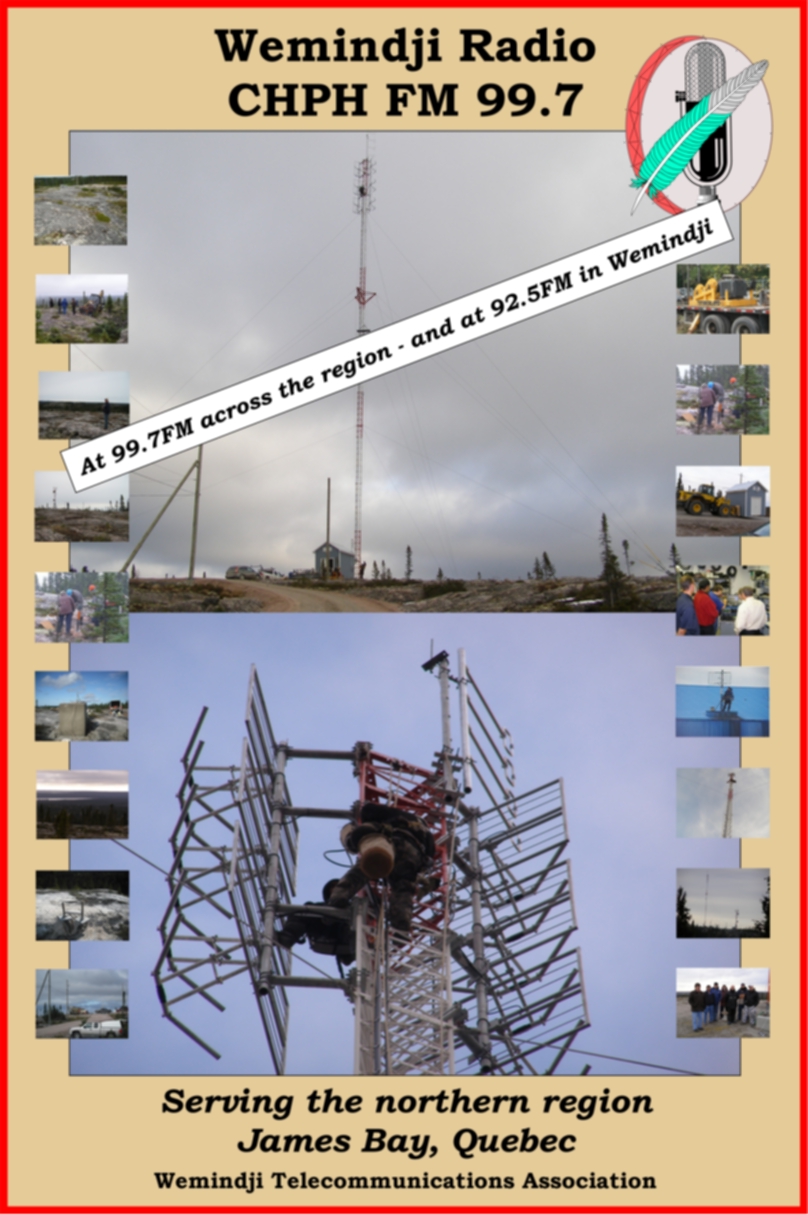--.--.--.--.--.--.--.--.--.--.--.--.--.--.--.--.--.--.--.--.--.--
Click here to view this photo book larger
________________________________
Before

After
__________________________________
Construction Project in Wemindji:
Across the Northern James Bay Region - Wemindji 99.7 FM at 30K Watts
On July 23, 2012, CHPH Wemindji expanded its community broadcast service with two FM signals: one low-power FM at 92.5 covering the immediate community of Wemindji and a separate frequency for high-power service at 99.7. The regional signal covers the northern James Bay region including over 120 Km of the previously-unserved James Bay Highway. The low-power frequency will allow Wemindji the potential to diversify programming.
RTS Canada undertook in 2008 to be project manager for construction of: a new 200 foot telecommunications tower on a remote 250 foot rock mountain near Wemindji, Quebec. Valued at $350,000, the project engaged 2 engineering groups, Yves Hamel in broadcasting and Trylon TSF in civil engineering; 3 construction subcontractors including VCC Construction of Val d'Or and Tawich Construction of Wemindji; and four equipment supppliers for antennas and and transmisster equipment. The tower project created 5 local jobs over a one-year period and a permanent position in maintenance. The tower is currently in place and has the capability to deliver regional FM radio, two-way radio with GPS tracking, microwave links and Wi-Fi service. The materials and labour used were 100% Canadian. Wemindji has a longstanding interest in telecom, being the first community in northern Quebec to have local dial-up Internet service in 1993 and cable Internet in 2007. It is now engaged in fire-optic and wireless deployment.
The tower and high-power FM stage of the project was completed in December 2009.
Telecommunications towers are the enablers of the wireless industry. They are critical infrastructures for all forms of wide-range telecommunications and their location, signal strength and height above ground level determine the footprint of the coverage area.
Across North America, there is a growing requirement for communities to integrate existing services with wireless technological advancement. Multiple services provide dependability. Just as broadcast services need network services to provide the public with information, news and entertainment, mobility requires inter-carrier operability to deliver communications services. From emergency services to communications for regional business, interconnected two-way services are indispensable.
Integration of multiple wireless services not only adds
value to available services but also is fundamental necessities to
adapt future uses of wireless technology as new developments come
online. These innovations include
- public Internet hotspots,
- community-wide mobility services for portable tele-medicine and
education,
- two-way radios that connect with the existing telephone and cellular
systems.
- relay towers that expand services into more remote and underserved
areas,
- mobile reception areas that allow GPS identification;
these improvements require integrating existing services to provide
new innovations

Integration of multiple services with wireless technology also means communities can expand emergency service areas. In addition, use of multiple wireless technologies guarantees continuity and reliability for a service application. For a community, a tower capable of reaching the widest area increases its ability to serve. For businesses, community services, health and emergency providers, broadcasters and governance, it means added value, serving all the people, all the time.
Recently, Industry Canada ordered all new communications and telecommunications wireless applicants to use existing towers, thus reducing the growing number of new towers. Existing licensed structures that have expansion capabilities were now provided with an economic potential not previously available. Issued June 2007, the directive told new applicants: "Proponents are not normally expected to build new antenna-supporting structures where it is feasible to locate their antenna on an existing structure, unless a new structure is preferred by land-use authorities." " (Industry Canada, CPC-2-0-03)
Currently, the following services use community-wide
wireless services in Wemindji:
- Wemindji Telecommunications Association (CHPH FM radio)
- Wemindji Trappers Association (two-way radio-phones)
- Tawich Construction (two-way radio-phones and paging)
- Wemindji Police (two-way radio-phones, paging, emergency services)
- Wemindji Fire (two-way radio-phone, paging, emergency service)
In addition, there are other community-wide wireless services including marine services, first responders, the Cree Board of Health and Social Services, and the CBC. New services coming online that will require facilities include the Cree regional police department currently in its organizational stage. Hydro-Québec also has regional microwave services.
Telebec, a Bell-owned telephone company, has cellular services and local microwave facilities. It currently uses its own facility, a 30-metre tower that provides a limited reach and virtually no potential for expansion.
Visit by Subject
